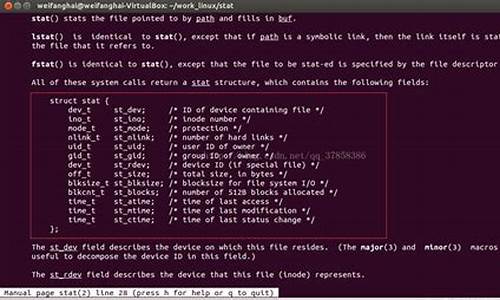1.linuxä¸cpå½ä»¤å¦ä½ç¨ Cè¯è¨å®ç°
2.记一次源码追踪分析,从Java到JNI,再到JVM的C++:fileChannel.map()为什么快;源码分析map方法,put方法

linuxä¸cpå½ä»¤å¦ä½ç¨ Cè¯è¨å®ç°
1ï¼é¦å éè¦äºè§£cpçåçã2ï¼å¯ä»¥åècpçæºç å»äºè§£å ¶åç
3ï¼cpå½ä»¤çæºç å¯ä»¥å¨linuxå æ ¸ä¸æ¾å°ã
4ï¼æè ä¸è½½busyboxå ¶ä¸ä¹ä¼æcpçæºç
åªæäºè§£å ¶åçä¹åæè½è°å¦ä½å®ç°ãåè代ç å¦ä¸ï¼
#include <stdio.h>#include <stdlib.h>
#include <sys/stat.h>
#include <sys/types.h>
#include <fcntl.h>
#include <errno.h>
#include <unistd.h>
#include <string.h>
#define BUF_SIZE
#define PATH_LEN
void my_err(char *err_string, int line )
{
fprintf(stderr,"line:%d ",line);
perror(err_string);
exit(1);
}
void copy_data(const int frd,const int fwd)
{
int read_len = 0, write_len = 0;
unsigned char buf[BUF_SIZE], *p_buf;
while ( (read_len = read(frd,buf,BUF_SIZE)) ) {
if (-1 == read_len) {
my_err("Read error", __LINE__);
}
else if (read_len > 0) { //æ读åé¨ååå ¥ç®æ æ件
p_buf = buf;
while ( (write_len = write(fwd,p_buf,read_len)) ) {
if(write_len == read_len) {
break;
}
else if (write_len > 0) { //åªåå ¥é¨å
p_buf += write_len;
read_len -= write_len;
}
else if(-1 == write_len) {
my_err("Write error", __LINE__);
}
}
if (-1 == write_len) break;
}
}
}
int main(int argc, char **argv)
{
int frd, fwd; //读åæ件æ述符
int len = 0;
char *pSrc, *pDes; //åå«æåæºæ件路å¾åç®æ æ件路å¾
struct stat src_st,des_st;
if (argc < 3) {
printf("ç¨æ³ ./MyCp <æºæ件路å¾> <ç®æ æ件路å¾>\n");
my_err("arguments error ", __LINE__);
}
frd = open(argv[1],O_RDONLY);
if (frd == -1) {
my_err("Can not opne file", __LINE__);
}
if (fstat(frd,&src_st) == -1) {
my_err("stat error",__LINE__);
}
/*æ£æ¥æºæ件路å¾æ¯å¦æ¯ç®å½*/
if (S_ISDIR(src_st.st_mode)) {
my_err("ç¥è¿ç®å½",__LINE__);
}
pDes = argv[2];
stat(argv[2],&des_st);
if (S_ISDIR(des_st.st_mode)) { //ç®æ è·¯å¾æ¯ç®å½ï¼å使ç¨æºæ件çæ件å
len = strlen(argv[1]);
pSrc = argv[1] + (len-1); //æåæåä¸ä¸ªå符
/*å æ¾åºæºæ件çæ件å*/
while (pSrc >= argv[1] && *pSrc != '/') {
pSrc--;
}
pSrc++;//æåæºæ件å
len = strlen(argv[2]);
// . 表示å¤å¶å°å½åå·¥ä½ç®å½
if (1 == len && '.' == *(argv[2])) {
len = 0; //没æç³è¯·ç©ºé´ï¼åé¢å°±ä¸ç¨éæ¾
pDes = pSrc;
}
else { //å¤å¶å°æç®å½ä¸ï¼ä½¿ç¨æºæ件å
pDes = (char *)malloc(sizeof(char)*PATH_LEN);
if (NULL == pDes) {
my_err("malloc error ", __LINE__);
}
strcpy(pDes,argv[2]);
if ( *(pDes+(len-1)) != '/' ) { //ç®å½ç¼ºå°æåç'/'ï¼åè¡¥ä¸â/â
strcat(pDes,"/");
}
strcat(pDes+len,pSrc);
}
}
/* æå¼ç®æ æä»¶ï¼ ä½¿æéä¸æºæ件ç¸å*/
fwd = open(pDes,O_WRONLY | O_CREAT | O_TRUNC,src_st.st_mode);
if (fwd == -1) {
my_err("Can not creat file", __LINE__);
}
copy_data(frd,fwd);
//puts("end of copy");
if (len > 0 && pDes != NULL)
free(pDes);
close(frd);
close(fwd);
return 0;
}
记一次源码追踪分析,从Java到JNI,再到JVM的网站源码变现C++:fileChannel.map()为什么快;源码分析map方法,put方法
前言
在系统IO相关的系统调用有read/write,mmap,sendfile等这些。
其中read/write是普通的读写,每次都需要将buffer从用户空间拷贝到内核空间;
而mmap使用的是内存映射,会将磁盘文件对应的页映射(拷贝)到内核空间的page cache,并记录到用户进程的页表中,使得用户空间也可以像操作用户空间一样操作该文件的映射,最后再由操作系统来讲该映射(脏页)回写到磁盘;
sendfile则使用的是零拷贝技术,在mmap的基础上,当发送数据的内核源码包安装时候只拷贝fd和offset等元数据信息,而将数据主体直接拷贝至protocol buffer,实现了内核数据零冗余的零拷贝技术
本文地址:/post//
问题/目的问题1Java中哪些API使用到了mmap问题2怎么知道该API使用到了mmap,如何追踪程序的系统调用目的1源码中分析验证,从Java到JNI,再到C++:fileChannel.map()使用的是系统调用mmap目的2源码验证分析:调用mmapedByteBuffer.put(Byte[])时JVM在搞些什么?mmap比普通的read/write快在哪?揭晓答案1mmap在Java NIO中的体现/使用看一个例子
// 1GBpublic static final int _GB = 1**;File file = new File("filename");FileChannel fileChannel = new RandomAccessFile(file, "rw").getChannel();MappedByteBuffer mmapedByteBuffer = fileChannel.map(FileChannel.MapMode.READ_WRITE, 0, _GB);for (int i = 0; i < _GB; i++) { count++;mmapedByteBuffer.put((byte)0);}其中fileChannel.map()底层使用的就是系统调用mmap,函数签名为: public abstract MappedByteBuffer map(MapMode mode,long position, long size)throws IOException
答案2程序执行的系统调用追踪/** * @author Tptogiar * @description * @date /5/ - : */public class TestMappedByteBuffer{ public static final int _4kb = 4*;public static final int _GB= 1**;public static void main(String[] args) throws IOException, InterruptedException { // 为了方便在日志中找到本段代码的开始位置和结束位置,这里利用文件io来打开始标记FileInputStream startInput = null;try { startInput = new FileInputStream("start1.txt");startInput.read();} catch (IOException e) { e.printStackTrace();}File file = new File("filename");FileChannel fileChannel = new RandomAccessFile(file, "rw").getChannel();MappedByteBuffer map = fileChannel.map(FileChannel.MapMode.READ_WRITE, 0, _GB); //我们想分析的语句问题2for (int i = 0; i < _GB; i++) { map.put((byte)0); // 下文中需要分析的语句目的2}// 打结束标记FileInputStream endInput = null;try { endInput = new FileInputStream("end.txt");endInput.read();} catch (IOException e) { e.printStackTrace();}}}把上面这段代码编译后把“.class”文件拉到linux执行,并用linux上的obv背离源码公式strace工具记录其系统调用日志,拿到日志文件我们可以在日志中看到以下信息(关于怎么拿到日志可以参照我的博文:无(代写)):
注:日志有多行,这里只选取我们关注的
// ...// 看到了我们打的开始标志openat(AT_FDCWD, "start1.txt", O_RDONLY) = -1 ENOENT (No such file or directory)// ... // 打开文件,文件描述符fd为6openat(AT_FDCWD, "filename", O_RDWR|O_CREAT, ) = 6// 判断文件状态fstat(6, { st_mode=S_IFREG|, st_size=, ...}) = 0// ... // 判断文件状态fstat(6, { st_mode=S_IFREG|, st_size=, ...}) = 0// 进行内存映射mmap(NULL, , PROT_READ|PROT_WRITE, MAP_SHARED, 6, 0) = 0x7f2fd6cd// ...// 程序退出exit(0)// 看到了我们打的结束标志openat(AT_FDCWD, "end.txt", O_RDONLY) = -1 ENOENT (No such file or directory)在上面程序的系统调用日志中我们确实看到了我们打的开始标志,结束标志。在开始标志和结束标志之间我们看到了我们的文件"filename"确实被打开了,文件描述符fd = 6;在打开文件后紧接着又执行了系统调用mmap,这一点我们Java代码一致,这样,jmeter插件源码解读我们就验证了我们答案1中的结论,可以开始我们的下文了
源码追踪分析,从Java到JNI,再到JVM的C++目的1寻源之旅:fileChannel.map()我们知道我们执行Java代码fileChannel.map()确实会在底层调用系统调用,那怎么在源码中得到验证呢?怎么落脚于源码进行分析呢?下面开始我们的寻源之旅
FileChannelImpl.map() 注:由于代码较长,这里代码中略去了一些我们不关注的,比如异常捕获等
public MappedByteBuffer map(MapMode mode, long position, long size)throws IOException{ // ...try { // ...synchronized (positionLock) { // ...long mapPosition = position - pagePosition;mapSize = size + pagePosition;try { // !我们要找的语句就在这!addr = map0(imode,多彩指标源码公式 mapPosition, mapSize);} catch (OutOfMemoryError x) { // 如果内存不足,先尝试进行GCSystem.gc();try { Thread.sleep();} catch (InterruptedException y) { Thread.currentThread().interrupt();}try { // 再次试着mmapaddr = map0(imode, mapPosition, mapSize);} catch (OutOfMemoryError y) { // After a second OOME, failthrow new IOException("Map failed", y);}}} // ...} finally { // ...}}上面函数源码中真正执行mmap的语句是在addr = map0(imode, mapPosition, mapSize),于是我们寻着这里继续追踪
FileChannelImpl.map0()
// Creates a new mappingprivate native long map0(int prot, long position, long length)throws IOException;可以看到,该方法是一个native方法,所以后面的源码我们需要到这个FileChannelImpl.class对应的fileChannelImpl.c中去看,所以我们需要去找到JDK的源码
在JDK源码中我们找到fileChannelImpl.c文件
fileChannelImpl.c 根据JNI的对应规则,我们找到该文件内对应的Java_sun_nio_ch_FileChannelImpl_map0方法,其源码如下:
JNIEXPORT jlong JNICALLJava_sun_nio_ch_FileChannelImpl_map0(JNIEnv *env, jobject this, jint prot, jlong off, jlong len){ void *mapAddress = 0;jobject fdo = (*env)->GetObjectField(env, this, chan_fd);jint fd = fdval(env, fdo);int protections = 0;int flags = 0;if (prot == sun_nio_ch_FileChannelImpl_MAP_RO) { protections = PROT_READ;flags = MAP_SHARED;} else if (prot == sun_nio_ch_FileChannelImpl_MAP_RW) { protections = PROT_WRITE | PROT_READ;flags = MAP_SHARED;} else if (prot == sun_nio_ch_FileChannelImpl_MAP_PV) { protections =PROT_WRITE | PROT_READ;flags = MAP_PRIVATE;}// !我们要找的语句就在这里!mapAddress = mmap(0,/* Let OS decide location */len,/* Number of bytes to map */protections,/* File permissions */flags,/* Changes are shared */fd, /* File descriptor of mapped file */off); /* Offset into file */if (mapAddress == MAP_FAILED) { if (errno == ENOMEM) { JNU_ThrowOutOfMemoryError(env, "Map failed");return IOS_THROWN;}return handle(env, -1, "Map failed");}return ((jlong) (unsigned long) mapAddress);}我们要找的语句就上面代码中的mapAddress = mmap(0,len,protections,flags,fd,off),至于为什么不是直接的mmap,而是mmap,是因为这里的mmap是一个宏,在文件上方有其定义,如下:
#define mmap mmap至此,我们就在源码中得到验证了我们问题2中的结论:fileChannelImpl.map()底层使用的是mmap系统调用
目的2寻源之旅:mmapedByteBuffer.put(Byte[ ])接着我们来看看当我们调用mmapedByteBuffer.put(Byte[])JVM底层在搞些什么动作
MappedByteBuffer ?首先我们得知道,当我们执行MappedByteBuffer map = fileChannel.map(FileChannel.MapMode.READ_WRITE, 0, _GB)时,实际返回的对象是DirectByteBuffer类的实例,因为MappedByteBuffer为抽象类,且只有DirectByteBuffer继承了它,看下面两图就明白了
DirectByteBuffer 于是我们找到DirectByteBuffer内的put(Byte[ ])方法
public ByteBuffer put(byte x) { unsafe.putByte(ix(nextPutIndex()), ((x)));return this;}可以看到该方法内实际是调用Unsafe类内的putByte方法来实现功能的,所以我们还得去看Unsafe类
Unsafe.class
public native voidputByte(long address, byte x);该方法在Unsafe内是一个native方法,所以所以我们还得去看unsafe.cpp文件内对应的实现
unsafe.cpp
在JDK源码中,我们找到unsafe.cpp
在这份源码内,没有使用JNI内普通加前缀的方法来形成对应关系
不过我们还是能顺着源码的蛛丝轨迹找到我们要找的方法
注意到源码中有这样的注册机制,所以我们可以知道我们要找的代码就是上图中标注的代码
顺藤摸瓜,我们就找到了该方法的定义
UNSAFE_ENTRY(void, Unsafe_SetNative##Type(JNIEnv *env, jobject unsafe, jlong addr, java_type x)) \UnsafeWrapper("Unsafe_SetNative"#Type); \JavaThread* t = JavaThread::current(); \t->set_doing_unsafe_access(true); \void* p = addr_from_java(addr); \*(volatile native_type*)p = x; \t->set_doing_unsafe_access(false); \UNSAFE_END \该方法内主要的逻辑语句就是以下两句:
/** * @author Tptogiar * @description * @date /5/ - : */public class TestMappedByteBuffer{ public static final int _4kb = 4*;public static final int _GB= 1**;public static void main(String[] args) throws IOException, InterruptedException { // 为了方便在日志中找到本段代码的开始位置和结束位置,这里利用文件io来打开始标记FileInputStream startInput = null;try { startInput = new FileInputStream("start1.txt");startInput.read();} catch (IOException e) { e.printStackTrace();}File file = new File("filename");FileChannel fileChannel = new RandomAccessFile(file, "rw").getChannel();MappedByteBuffer map = fileChannel.map(FileChannel.MapMode.READ_WRITE, 0, _GB); //我们想分析的语句问题2for (int i = 0; i < _GB; i++) { map.put((byte)0); // 下文中需要分析的语句目的2}// 打结束标记FileInputStream endInput = null;try { endInput = new FileInputStream("end.txt");endInput.read();} catch (IOException e) { e.printStackTrace();}}}0至此,我们就知道:其实我们调用mmapedByteBuffer.put(Byte[ ])时,JVM底层并不需要涉及到系统调用(这里也可以用strace工具追踪从而得到验证)。也就是说通过mmap映射的空间在内核空间和用户空间是共享的,我们在用户空间只需要像平时使用用户空间那样就行了————获取地址,设置值,而不涉及用户态,内核态的切换
总结fileChannelImpl.map()底层用调用系统函数mmap
fileChannelImpl.map()返回的其实不是MappedByteBuffer类对象,而是DirectByteBuffer类对象
在linux上可以通过strace来追踪系统调用
JNI中“.class”文件内方法与“.cpp”文件内函数的对应关系不止是前缀对应的方法,还可以是注册的方式,这一点的追寻代码的时候有很大帮助
directByteBuffer.put()方法底层并没有涉及系统调用,也就不需要涉及切态的性能开销(其底层知识执行获取地址,设置值的操作),所以mmap的性能就比普通读写read/write好
...
原文:/post/